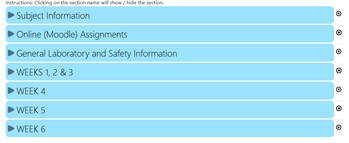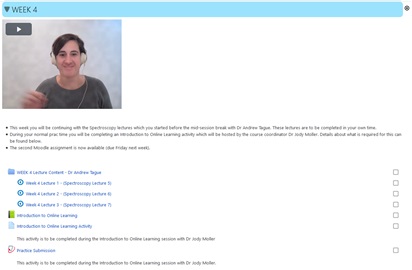Structuring chemistry practicals in Moodle

Dr Jody Moller | Science, Medicine and Health (SMAH)
Adding features such as weekly topics, Moodle books and summary videos to my Moodle site helped my students to easily navigate the subject content, while also getting to know me as their Subject Coordinator.
I just want to take you through some of the changes we made to our Moodle site, which really improved our structure and our connection with our students.
The first one was to go to a weekly structure. Students really appreciated having everything really easy to find in a single location. And in addition to our weekly structure, we also provide a weekly video update. I mean, this gave us a really good social connection with our students.
So as the coordinator, I recorded myself every single week, just giving a general update about the subject, talking about what they needed to cover in any given week, and that was something that allowed me to really connect with my students in a really meaningful way.
We also use Moodle books. So Moodle books are a fabulous tool if you haven't already used them for keeping all of your content in a logical order and allowing students to find information really easily.
Recommendations for me, build on what you already have in your in your Moodle site. Be consistent so it's easy for students to find information. Be bold, try something new. Students really appreciated the changes we made this session and I hope you can use some of these hints and tips to improve your own Moodle site.
Moving all content online meant some changes to how the CHEM212 site was structured. Weekly topics were added, releasing week-by-week. This meant all content was in one place for students, students were forced to focus on one new topic at a time and that content could be developed throughout the session.
Moodle books were used to group practical materials together. Moodle books were also a great way to direct students through the content seamlessly, from content to activity to submission link.

This structure also helped each week's content to be consistent so students were less confused. A weekly, informal summary video was uploaded each Monday, where students could access a clear and concise summary of the week ahead. This video also helped students get to know the Subject Coordinator and put a face to the name. This information was then repeated in another mode via dot points underneath. Students also had the Announcements forum and forums where they could access new information and ask questions. At the beginning of the transition, a specific live class was held to explain the layout of the Moodle site, as well as subject expectations.
How?
The old CHEM212 site was ordered by activity type, so practicals were simply placed in their own topics and renamed as weeks. This process was relatively easy, and other materials were simply added onto these. For practicals that ran over two weeks, resources were copied into the next week and clearly labelled as copies. The only drawback was that students needed to go back to the week they submitted to access feedback for Quizzes (marks were automatically moved to Gradebook). However, the move to weekly topics was worth it overall.
Moodle books made practicals and topic quizzes consistent in how they were accessed by students and linked to other subject material. These lectures could simply be linked to Echo360 in the books. Having multiple lecturers meant that the lecture structure differed, so with more time in the future, embedding them into Moodle books would be interesting.
I found that creating clear, consistent summary videos was as easy as writing a SOLSMail, while also allowing me to connect with students. Adding a video was easy within Moodle, and as our lectures were narrated slides, students liked the chance to see a face! Tutorial access (via Webex links) was placed at the top of the Moodle site, so that students could clearly and consistently find theirs to attend.
Reflection
If possible, building a Moodle site from scratch instead of copying it over, may be easier. This would avoid having strange tables or colours than cannot be deleted. In CHEM212, some of these stubborn features had to be creatively integrated into the new look.
Having a consistent approach to presenting subject material was great, but this involved some serious pre-planning before Week 1. However, releasing material weekly meant that some things could be changed throughout the session, so it's not set in stone. Be bold and try something new - Moodle books were a huge success in this subject, but were completely new to me.
Support resources
- Moodle site format | L&T Hub resource
- Using Moodle Books | L&T Hub resource
- Adding an Echo360 video to your Subject Site | L&T Hub resource



